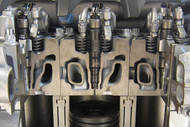Drive a Common Rail Diesel? You should probably read this
Published by Peter Harris on 13th Dec 2017

Why your common rail needs a catch can and fuel pre-filter
The modern diesel engine is a pretty awesome thing. Gone are the days of slow, rough and belching diesels that were tough to live with; these days diesel donks are powerful, efficient and quiet. On the flip side, they are much more complex than the good old days, and have some pretty tricky engineering that you should know about:
High-Pressure Fuel Injection
 Once upon a time, the fuel pump setup on a diesel was a fairly simple affair. There was a lift pump, which fed an injector pump. Then, the injector pump sorted out the timing and fuel dose for each injector. You can see where they get their reputation for being so simple.
Once upon a time, the fuel pump setup on a diesel was a fairly simple affair. There was a lift pump, which fed an injector pump. Then, the injector pump sorted out the timing and fuel dose for each injector. You can see where they get their reputation for being so simple.
These days, it’s a bit different. Firstly, you’ve got computers on-board that take care of the injection timing, no need for an injector pump for timing any more. What a common rail system does need, however, is fuel at a very high pressure.
Modern diesels use advanced pumps that develop up to 3,000psi of pressure in the fuel system. This feeds a reservoir right up near your injectors, called a ‘common rail’. It looks like a rail, and supplies your injectors with high-pressure fuel. The only problems with common rail are that they have much lower tolerances to wear and dirt than older system, and are only happy with clean fuel.
Trick injectors
 Injectors, controlled electronically and individually by the ECU, can use this ready supply of high-pressure diesel to inject a fine mist of fuel at the perfect moment. This keeps your diesel engine quiet, powerful and efficient.
Injectors, controlled electronically and individually by the ECU, can use this ready supply of high-pressure diesel to inject a fine mist of fuel at the perfect moment. This keeps your diesel engine quiet, powerful and efficient.
Common rail injectors are able to provide incredibly precise and controlled fuel injections, in terms of amount and spray pattern. Modern injectors will often go through multiple, different injections for each combustion cycle, all in the quest for cleanliness and efficiency. The injection is controlled by very accurate and delicate electromagnets (magnets that are controlled by an electric current) or piezoelectric (crystalline materials that change size from electric current).
Keep it clean
If you want to take good care of your fuel system, there is one simple solution: keeping your fuel clean. Recently introduced Australian Standards keeps a fairly high minimum requirement for fuel these days, but your biggest enemy is contaminants.

Stop dirt and water ruining your fuel system with two simple tips:
1: Change your factory fuel filter regularly, and only use good quality filters.
2: Install an additional fuel filter into your system, for extra protection. This will take the stress off your factory filter, and give your pump and injectors the best chance of a long, happy life.
More pressure
And of course, you can’t forget the turbocharger hanging off the side. Using spent exhaust gasses; the turbo compresses the air destined for the combustion chamber. Denser air means you can squeeze some extra fuel in, and make a bigger bang overall. Bigger bang equals more power.
Turbocharging is the main tool used to get big power out of relatively smaller modern power plants. At the end of the day, the engine is working a bit harder with a turbo to make that extra power, but there is one trick you can do it help out: Fit a catch can.
Fit an oil catch can
The oil catch can is a smart, simple device that keeps your engine running at it’s maximum. The engine crankcase needs to breath, especially if it’s a hard-working turbo diesel. This air, laden with oil mist, can’t be vented to the atmosphere. It has to be reintroduced back into the engine.
The problem with this is that as this oily air circulates through your EGR, intercooler, turbo, intake manifold and piping, it’s going to leave oil and carbon behind, which will slowly build up and reduce your engine’s power and efficiency. EGRs can be completely blocked with carbon, and intercoolers can literally fill with oil.
A properly installed catch can will intercept oil and crap in the crankcase gasses, filtering them out before they get reintroduced back to the engine. This keeps your engine cleaner overall, and running at it’s optimum performance.
One fine example is Catch Can Pro from Flashlube - the answer to carbon build up in modern engines
Check this video from Penny Wells for better understanding on how they work:
Check our Flashlube Catch Can Pro from Flashlube and Catch Can Pro & Fitting Kits suitable for plenty vehicles, find yours HERE



